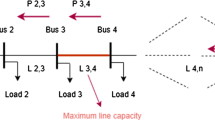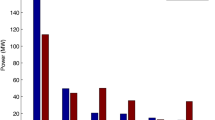Abstract
An important factor in reviewing the performance of generation units and calculating their profit is the calculation of their locational marginal price (LMP), and this depends on our knowledge on the capacity of transmission lines and optimal power flow (OPF) based on reality by which we aim to minimize the total cost of the generators, solve the congestion of transmission lines, and hence, reduce the price of electricity in the market. Since power flow equations are nonlinear, they should be solved using numerical and repetition-based methods. In this paper, genetic algorithm (GA) has been employed to solve these equations, and in order to improve the performance of GA in its structure, generating scaling factor (GSF) has also been used for simultaneous calculations of power passing through in transmission lines so that by gaining some knowledge on the capacity of transmission lines, in addition to optimal power flow becoming real, we could determine the electricity price by uniform market pricing or LMP methods depending on using the full capacity of lines and generating power of the units, and thus, we can calculate the profit of generators. Finally, the output of the proposed GA-GSF algorithm would include values of buses voltages, lines losses, injected power to buses, power passing through lines, total generation cost, and generators’ profits. Also, the proposed algorithm in this paper has been tested on IEEE 14-BUS, IEEE 30-BUS, IEEE 57-BUS network, and the results show improvements on the OPF problem.











Similar content being viewed by others
References
Vasant PM (2012) Meta-heuristics optimization algorithms in engineering, business, economics, and finance. p 734. https://doi.org/10.4018/978-1-4666-2086-5
Shahidehpour M, Alomoush M (2001) Restructured electrical power systems: operation, trading, and volatility. Marcel Dekker, New York
Alomoush M (2003) Derivation of UPFC DC load flow model with examples of its use restructured power systems. IEEE Trans Power Syst 18(3):1173–1180
Stott B, Marinho JL (1979) Linear programming for power system network security applications. IEEE Trans Power Appar Syst PAS-98:837–848
Reid GF, Hasdorf L (1973) Economic dispatch using quadratic programming. IEEE Trans Power Appar Syst PAS-92:2015–2023
Dommel HW, Tinney WF (1968) Optimal power flow solutions. IEEE Trans Power Appar Syst PAS-87:1866–1876
Sinha N, Chakrabarti R, Chattopadhyay PK (2003) Evolutionary programming techniques for economic load dispatch. IEEE Trans Evol Comput 7(1):83–94
Bouktir T, Slimani L, Belkacemi M (2004) A genetic algorithm for solving the optimal power flow problem. Leonardo J Sci 4:44–58
Kennedy J, Eberhart RC (1995) Particle swarm optimization. In: Proceedings of IEEE international conference on neural networks (ICNN’95). Perth, Australia, vol IV, pp 1942–1948
Chen CH, Yeh SN (2006) Particle swarm optimization for economic power dispatch with valve-point effects. In: 2006 IEEE PES transmission and distribution conference and exposition Latin America, Venezuela
Chaturvedi KT, Pandit M, Srivastava L (2008) Self organizing hierarchical particle swarm optimization for nonconvex economic dispatch. IEEE Trans Power Syst 23(3):1079–1087
Yoshida H, Kawata K, Fukuyama Y, Nakanishi Y (2001) A particle swarm optimization for reactive power and voltage control considering voltage security assessment. IEEE Trans Power Syst 15(4):1232–1239
Krost G, Venayagamoorthy GK, Grant L (2008) Swarm intelligence and evolutionary approaches for reactive power and voltage control. In: 2008 IEEE swarm intelligence symposium
Mo N, Zou ZY, Chan KW, Pong TYG (2007) Transient stability constrained optimal power flow using particle swarm optimization. IEEE Gener Transm Distrib 1(3):476–483
Swarup KS (2006) Swarm intelligence approach to the solution of optimal power flow. Indian Inst Sci 86(5):439–455
Abou El-Ela AA, El-Sehiemy RAA (2007) Optimized generation costs using modified particle swarm optimization version. WSEAS Trans Power Syst 10(2):225–232
Abido MA (2002) Optimal power flow using particle swarm optimization. Electr Power Energy Syst 24(2002):563–571
Park J-B, Jeong Y-W, Lee W-N, Shin J-R (2006) An improved particle swarm optimization for economic dispatch problems with non-smooth cost functions. In: IEEE power engineering society general meeting
Thanushkodi K, Muthu Vijaya Pandian S, Dhivy Apragash RS, Jothikumar M, Sriramnivas S, Vindoh K (2008) An efficient particle swarm optimization for economic dispatch problems with nonsmooth cost functions. WSEAS Trans Power Syst 3(4):257–266
Meng Ke et al (2010) Quantum-inspired particle swarm optimization for valve point economic load dispatch. IEEE Trans Power Syst 25(1):215–222
Vaisakh K, Srinivas LR (2005) Differential evolution approach for optimal power flow solutions. J Theor Appl Inf Technol 2:261–268
Allaoua B, Laoufi A (2009) Optimal power flow solution using ant manners for electrical network. Adv Electr Comput Eng 9(1):34–40
Haibo Z, Lizi Z, Fanling M (1998) Reactive power optimization based on genetic algorithm. In: International power conference on power system technology. pp 1448–1453
Sulaiman MH, Mustafa MW, Aliman O (2009) Transmission loss and load flow allocations via genetic algorithm technique. IEEE Xplore, TENCON
Hazra J, Sinha AK (2007) A study on real and reactive power optimization using particle swarm optimization. In: International conference on industrial and information systems. pp 323–328
Rahul J, Sharma Y, Birla D (2012) A new attempt to optimize optimal power flow based transmission losses using genetic algorithm. In: Computational intelligence and communication networks (CICN), IEEE Xplore
Vu PT, Le DL, Vo ND (2010) A novel weight-improved particle swarm optimization algorithm for optimal power flow and economic load dispatch problems. In: Transmission and distribution conference and exposition
Kumar S, Chaturvedi DK, Grant L (2013) Optimal power flow solution using fuzzy evolutionary and swarm optimization. Int J Electr Power Energy Syst 47:416–423
Goswamia SK, Acharjee P (2010) Multiple low voltage power flow solutions using hybrid PSO and optimal multiplier method. Expert Syst Appl 37(3):2473–2476
Najafi M, Ahmadi S, Dashtdar M (2015) Simultaneous energy and reserve market clearing with consideration of interruptible loads as one of demand response resources and different reliability requirements of consumers. Int J Emerg Electr Power Syst. https://doi.org/10.1515/ijeeps-2019-0018
Sinsuphan N, Leeton U, Kulworawanichpong T (2013) Optimal power flow solution using improved harmony search method. Power Syst Res Unit 13(5):2364–2374
Acknowledgements
This work was supported by the KIEE.
Author information
Authors and Affiliations
Corresponding author
Additional information
Publisher's Note
Springer Nature remains neutral with regard to jurisdictional claims in published maps and institutional affiliations.
Rights and permissions
About this article
Cite this article
Dashtdar, M., Najafi, M. & Esmaeilbeig, M. Calculating the locational marginal price and solving optimal power flow problem based on congestion management using GA-GSF algorithm. Electr Eng 102, 1549–1566 (2020). https://doi.org/10.1007/s00202-020-00974-z
Received:
Accepted:
Published:
Issue Date:
DOI: https://doi.org/10.1007/s00202-020-00974-z




